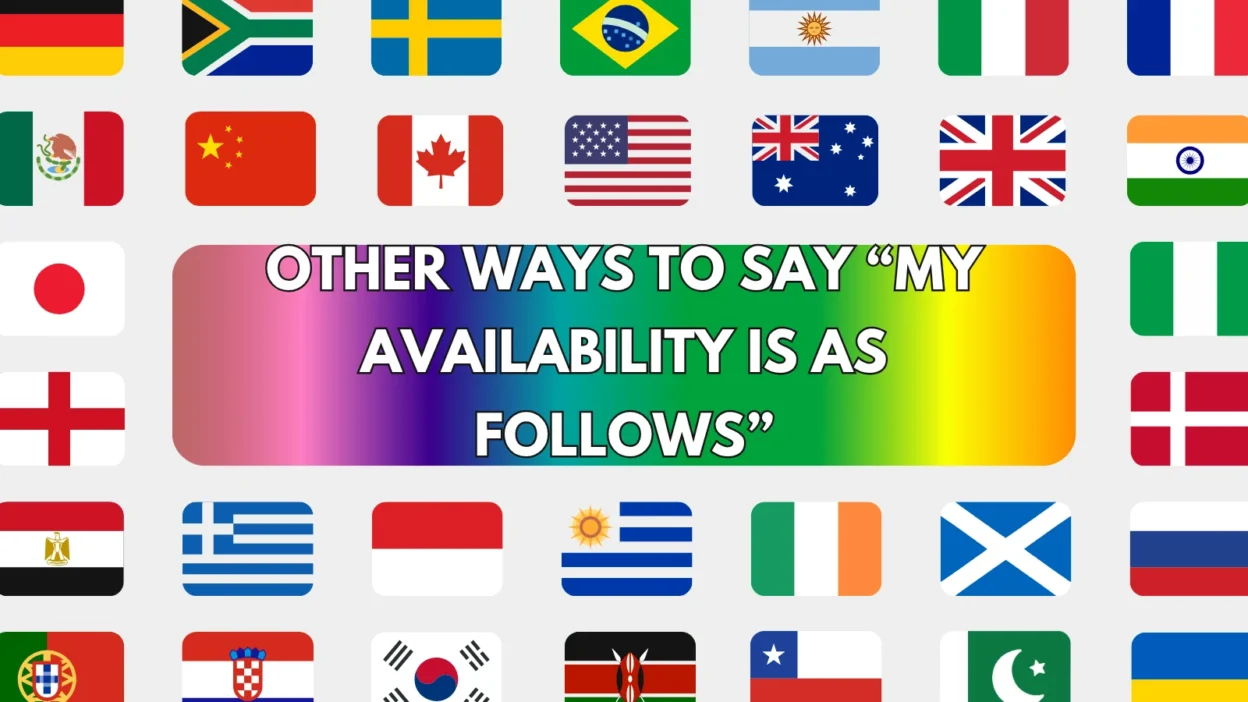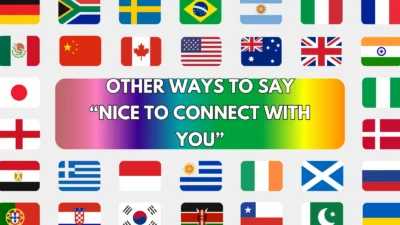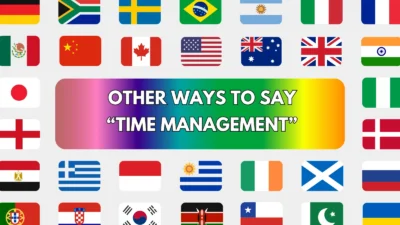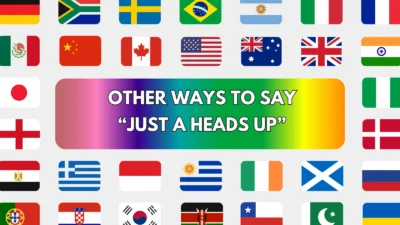When scheduling meetings, interviews, or appointments, the phrase “My availability is as follows” is clear and professional — but it can sound a bit formal or repetitive if you use it often. Whether you’re writing to a client, colleague, or recruiter, there are many smoother, friendlier, or more polished ways to express the same idea.
Here are 25 alternatives to say “My availability is as follows,” along with meanings, explanations, and examples to fit different tones and contexts.
1. Here’s when I’m available
Meaning: A friendly, concise way to share your open times.
Detailed Explanation: Simple and conversational while staying professional.
Scenario Example: Here’s when I’m available: Monday to Wednesday, 10 AM–2 PM.
Best Use: Emails, chats, informal scheduling.
Tone: Friendly, approachable.
2. I’m available at the following times
Meaning: A straightforward restatement of your availability.
Detailed Explanation: Professional and polite; great for formal communication.
Scenario Example: I’m available at the following times: Tuesday or Thursday afternoon.
Best Use: Work emails, HR correspondence.
Tone: Neutral, respectful.
3. You can reach me during these times
Meaning: Invites contact during specific hours.
Detailed Explanation: Indicates your preferred time slots for communication.
Scenario Example: You can reach me during these times: 9 AM–1 PM, Monday to Friday.
Best Use: Scheduling or collaboration.
Tone: Courteous, professional.
4. These are the times that work best for me
Meaning: Politely suggests your preferred time slots.
Detailed Explanation: Adds flexibility and sounds considerate.
Scenario Example: These are the times that work best for me: Tuesday morning or Friday afternoon.
Best Use: Collaborative scheduling, meetings.
Tone: Cooperative, friendly.
5. I’m free at the following times
Meaning: Informal and direct way to list your open hours.
Detailed Explanation: Ideal for relaxed or internal conversations.
Scenario Example: I’m free at the following times: Wednesday 3 PM or Thursday 11 AM.
Best Use: Internal messages, quick replies.
Tone: Casual, straightforward.
6. The best times for me are…
Meaning: Emphasizes your preferred schedule without being rigid.
Detailed Explanation: Communicates flexibility while being clear.
Scenario Example: The best times for me are Monday morning or Thursday after 2 PM.
Best Use: Collaborative discussions.
Tone: Friendly, adaptable.
7. I’m open at these times
Meaning: A short, easy-to-understand version.
Detailed Explanation: Keeps the message casual but clear.
Scenario Example: I’m open at these times: Wednesday or Friday around noon.
Best Use: Quick chats, team scheduling.
Tone: Relaxed, conversational.
8. My open slots are as follows
Meaning: A bit more formal version of “I’m free.”
Detailed Explanation: Suggests time windows available for meetings.
Scenario Example: My open slots are as follows: Tuesday 10 AM or Thursday 4 PM.
Best Use: Business scheduling.
Tone: Professional, polite.
9. Here’s my schedule for availability
Meaning: Shares your open times in a structured way.
Detailed Explanation: Good for long-term or weekly planning.
Scenario Example: Here’s my schedule for availability this week: Mon–Fri, 9 AM–3 PM.
Best Use: Corporate settings, coordination emails.
Tone: Organized, formal.
10. I’m available to meet at…
Meaning: Focuses specifically on meeting times.
Detailed Explanation: Works perfectly when proposing meeting slots.
Scenario Example: I’m available to meet at 11 AM or 3 PM on Wednesday.
Best Use: Meeting arrangements.
Tone: Polite, clear.
11. I’m open for a call during these times
Meaning: Specifies availability for phone or video calls.
Detailed Explanation: Tailored for virtual communication.
Scenario Example: I’m open for a call during these times: Tuesday or Thursday mornings.
Best Use: Remote work, interviews.
Tone: Professional, courteous.
12. The times I can do are…
Meaning: Simple and conversational.
Detailed Explanation: A natural phrase often used in everyday speech.
Scenario Example: The times I can do are Monday 2 PM or Wednesday 10 AM.
Best Use: Informal settings.
Tone: Casual, direct.
13. I’m good for…
Meaning: A very casual way to offer times that work.
Detailed Explanation: Best used when communicating with familiar colleagues or friends.
Scenario Example: I’m good for Friday afternoon if that works for you.
Best Use: Internal or friendly communication.
Tone: Relaxed, informal.
14. I’m open to meeting at…
Meaning: Shows willingness to adjust your schedule.
Detailed Explanation: Keeps tone flexible and collaborative.
Scenario Example: I’m open to meeting at 10 AM or 3 PM on Tuesday.
Best Use: Polite coordination.
Tone: Cooperative, positive.
15. Here’s when I have time
Meaning: Simple, conversational, and to the point.
Detailed Explanation: Keeps communication smooth and natural.
Scenario Example: Here’s when I have time: Wednesday morning or Friday noon.
Best Use: Informal emails, team chats.
Tone: Easygoing, polite.
16. My schedule allows for…
Meaning: Professional phrasing to show available times.
Detailed Explanation: Ideal for formal or respectful correspondence.
Scenario Example: My schedule allows for a meeting on Thursday afternoon.
Best Use: Corporate communication.
Tone: Polished, professional.
17. I’m available to connect at…
Meaning: Expresses openness to a meeting or call.
Detailed Explanation: Sounds warm and collaborative.
Scenario Example: I’m available to connect at 2 PM on Wednesday or Friday.
Best Use: Networking, professional meetings.
Tone: Polite, modern.
18. You can book me for…
Meaning: Suggests open time slots in a structured way.
Detailed Explanation: Works well with calendar-based scheduling tools.
Scenario Example: You can book me for Thursday morning or Friday afternoon.
Best Use: Digital meetings, client communication.
Tone: Practical, confident.
19. I’m free to chat at…
Meaning: Friendly phrase for casual or quick discussions.
Detailed Explanation: Perfect for coworkers or social meetings.
Scenario Example: I’m free to chat at 11 AM or later today if that suits you.
Best Use: Informal, casual check-ins.
Tone: Light, conversational.
20. I’m open these days/times
Meaning: Shares flexible time options.
Detailed Explanation: Communicates availability without sounding rigid.
Scenario Example: I’m open these times: Monday afternoon or Wednesday morning.
Best Use: Flexible planning, friendly tone.
Tone: Warm, adaptable.
21. The windows I have open are…
Meaning: Refers to available time blocks.
Detailed Explanation: Suggests limited but clear availability.
Scenario Example: The windows I have open are Tuesday 1–3 PM and Friday morning.
Best Use: Business or tight scheduling.
Tone: Polite, precise.
22. I can make time at…
Meaning: Suggests willingness to adjust your schedule.
Detailed Explanation: Shows flexibility and cooperation.
Scenario Example: I can make time at 2 PM on Thursday if that works for you.
Best Use: Professional courtesy.
Tone: Helpful, considerate.
23. I’m available around…
Meaning: Shares approximate rather than fixed times.
Detailed Explanation: Adds flexibility to scheduling.
Scenario Example: I’m available around noon on Friday or early Monday morning.
Best Use: Informal or flexible arrangements.
Tone: Friendly, open.
24. I’m happy to meet at…
Meaning: Combines politeness with enthusiasm.
Detailed Explanation: Expresses both gratitude and readiness.
Scenario Example: I’m happy to meet at 11 AM on Tuesday or 3 PM Thursday.
Best Use: Client meetings, friendly communication.
Tone: Positive, courteous.
25. My current openings are…
Meaning: Refers to free times in your schedule.
Detailed Explanation: Ideal for professional scheduling or booking systems.
Scenario Example: My current openings are Monday morning and Thursday afternoon.
Best Use: Business correspondence, client meetings.
Tone: Professional, concise.
Conclusion
Saying “My availability is as follows” is perfectly fine, but variety adds warmth and personality to your communication. Whether you say “Here’s when I’m available,” “I can make time at…,” or “My current openings are…”, each version suits a different tone — from formal to friendly.
Choose the phrasing that fits your relationship with the person and the context to make your message sound more natural, clear, and approachable.




